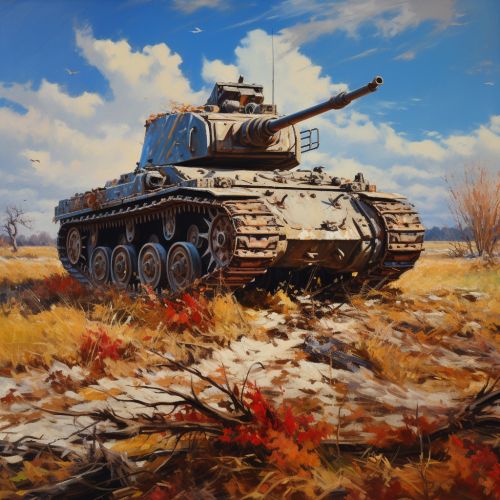Panzer IV
Development and Design
The Panzer IV, officially known as the Panzerkampfwagen IV (Pz.Kpfw. IV), was a medium tank developed by Nazi Germany during the late 1930s. It was designed by the German company Krupp-Grusonwerk, under the supervision of the German Army's Weapons Department. The tank was designed to operate in conjunction with the Panzer III, with the former providing infantry support while the latter engaged enemy tanks.


The Panzer IV was the most widely manufactured German tank of the Second World War, with over 8,500 units produced. It was the backbone of the German Panzer Divisions, serving on all fronts and in all major German offensives from 1941 to 1945.
Technical Specifications
The Panzer IV was powered by a Maybach HL 120 TRM engine, which provided a top speed of 38 km/h (24 mph) and a range of 200 km (120 miles). The tank's primary armament was a 75mm KwK 40 L/48 gun, capable of firing both high explosive and armor-piercing rounds. The tank also featured a secondary armament of two 7.92mm MG 34 machine guns, one mounted coaxially with the main gun and the other in the hull.
The armor of the Panzer IV varied throughout its production, starting with 30mm of homogeneous steel armor in the early models and increasing to 80mm in the later models. The tank's armor was designed to withstand the majority of anti-tank weapons of the period, with the exception of the most powerful guns such as the Soviet 85mm D-5T and the British 17-pounder.
Operational History
The Panzer IV first saw combat in the Invasion of Poland in 1939, where it performed well against the lightly armored Polish tanks. It was also used extensively in the Battle of France in 1940, where it played a key role in the German victory.
During the early stages of Operation Barbarossa, the German invasion of the Soviet Union, the Panzer IV was the only German tank capable of effectively engaging the heavily armored Soviet T-34 and KV-1 tanks. This led to an increase in production and the introduction of several upgrades to improve its combat effectiveness.
In the later stages of the war, the Panzer IV faced increasingly powerful Allied tanks such as the American M4 Sherman and the British Churchill, which outclassed it in terms of firepower and armor protection. Despite this, the Panzer IV remained in service until the end of the war, with some units continuing to use it in the post-war period.
Legacy
The Panzer IV is often regarded as one of the most successful German tank designs of the Second World War. Its balanced design, combined with its versatility and reliability, made it a formidable weapon on the battlefield. The tank's design influenced several post-war tanks, including the Israeli Merkava and the French AMX-30.
